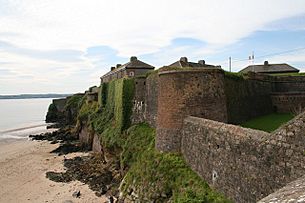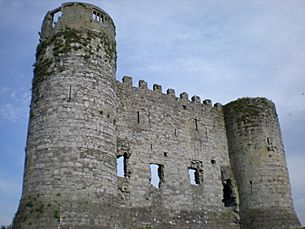Siege of Waterford facts for kids
Quick facts for kids Siege of Waterford |
|||||||
|---|---|---|---|---|---|---|---|
| Part of the Cromwellian Conquest of Ireland | |||||||
 Henry Ireton, the English Parliamentarian commander who took Waterford in 1650 |
|||||||
|
|||||||
| Belligerents | |||||||
| Commanders and leaders | |||||||
| Richard Farrell Thomas Preston |
Oliver Cromwell Michael Jones Henry Ireton |
||||||
| Strength | |||||||
| 3,000 | 6,000–7,000 | ||||||
The city of Waterford in southeast Ireland was attacked twice between 1649 and 1650. This happened during the Cromwellian conquest of Ireland. The city was defended by Irish Catholic soldiers and English Royalist troops. They were led by generals Richard Farrell and Thomas Preston.
The attackers were English Parliamentarian soldiers. Their leaders included Oliver Cromwell, Michael Jones, and Henry Ireton. The Parliamentarians eventually won the second siege.
Contents
Waterford: A Strong Catholic City
Waterford was a city with many Catholic people. Like other towns in southeast Ireland, it supported the Irish Catholic cause. This support began after the Irish Rebellion of 1641.
In 1641, Protestant people who had lost their homes came to Waterford. This caused problems with the Catholic citizens. Some city leaders wanted to protect the Protestants. But others wanted to let in the rebels who arrived outside the city walls in early 1642.
At first, the mayor managed to keep the rebels out. But by March 1642, the rebels' supporters in the city government took over. Protestants in Waterford were forced to leave. Many were put on ships to England. Sometimes, their belongings were stolen by angry crowds.
In 1645, Catholic troops led by Thomas Preston captured Duncannon nearby. This helped protect ships coming to and from Waterford.
Waterford's leaders were very strong in their Catholic beliefs. In 1646, Catholic bishops met in Waterford. They said that any Catholic who supported a peace deal with the English Royalists would be kicked out of the church. This was if the deal did not allow Catholics to practice their religion freely.
The Irish Catholics finally made a deal with Charles I of England in 1648. They joined forces with the Royalists. Their shared enemy was the English Parliament. The Parliament was against both Catholics and the King.
In August 1649, Oliver Cromwell and his English Parliamentarian army arrived in Ireland. One of Cromwell's goals was to punish the Irish. He believed they had mistreated Protestants in 1641. Waterford's strong Catholic history made its people very afraid. Their fear grew when they heard what happened at Drogheda and Wexford. These towns had been captured and their soldiers killed by Cromwell's forces.
Waterford was very important in the war. Its port allowed weapons and supplies to come from Europe. Its location also controlled the entrance to the Suir and Barrow rivers.
First Attack: Cromwell's Siege in 1649
Before attacking Waterford, Oliver Cromwell needed to capture nearby forts. These forts were held by Royalist and Catholic troops. Taking them would keep his supply lines safe.
Duncannon Fort guarded the sea route into Waterford. Parliamentarian soldiers, led by Ireton, attacked it from October 15 to November 5. But the fort's defenders, led by Edward Wogan, fought bravely. They held out, meaning Cromwell could not bring heavy siege cannons to Waterford by sea.
New Ross gave up to Cromwell on October 19. Carrick-on-Suir was taken on November 19. Irish soldiers from Ulster tried to attack Carrick on November 24. But they were pushed back, and 500 of them died.
Cromwell reached Waterford on November 24. He had cut off the city from the east and north. But Waterford could still get help from the west. About 3,000 Irish soldiers, from the Ulster Army, entered the city. They were led by Richard Farrell. Farrell was a skilled soldier from the Spanish army. He knew a lot about siege warfare. Cromwell was facing a very smart commander.
The weather was very cold and wet. Many Parliamentarian soldiers got sick. Out of 6,500 English soldiers, only about 3,000 were still healthy when the siege ended. Cromwell could not make much progress. He captured a fort at Passage East. This allowed him to bring siege guns by sea. But the wet weather made it impossible to move them close enough to Waterford's walls. Farrell's defense was too strong.
Cromwell had to stop the siege on December 2. He moved his army to Dungarvan for the winter. His commander, Michael Jones, died from disease during this time.
Second Attack: Ireton Takes the City in 1650
Waterford was not under a tight attack again until July 1650. But in the months before, it was slowly cut off. In January, its access to the west was blocked. In June, the Parliamentarian commander Ireton arrived outside the city.
By this time, Irish general Preston was defending Waterford. Preston's soldiers did not have enough food. Also, a terrible sickness, probably the bubonic plague, was spreading in the city. It was killing up to 400 people inside the walls each week.
In July, Carlow (about 70 km north of Waterford) fell to the Parliamentarians. This meant Waterford could no longer get supplies by the River Barrow.
Ireton ordered his men to dig trenches for his siege cannons. This would bring them close enough to break through the walls. He also blocked Waterford's port with Parliamentarian ships. By the end of July, his cannons could reach the walls.
At this point, Waterford's mayor and city leaders begged Preston to give up the city. He had only 700 healthy soldiers left. He also had only 500 pounds of gunpowder. He could not fight off an attack. Preston himself was very sick. If the city was taken by force, the lives and property of its defenders would not be safe.
Because of these reasons, Preston surrendered Waterford to Ireton on August 6, 1650. His soldiers were allowed to march away to Galway or Athlone. These cities were still held by Irish Catholics. But Preston had to give up all the cannons, ammunition, and ships in Waterford. Nearby Duncannon surrendered on August 12.
It is hard to know how many soldiers and citizens in Waterford died during the sieges. Ireton was kind to the people of Waterford when they surrendered. He respected their lives and property. In contrast, the next year in Limerick, he had the city's strongest defenders hanged.
Waterford was the last major Irish Catholic stronghold in eastern Ireland. It fell to the English Parliamentarian forces. After its fall, the Irish Catholic forces only held a small area in the west of Ireland, called Connacht.
See also
- Siege of Waterford (1495), an earlier siege in the 15th century that was not related.
Sources
- Gentles, Ian The New Model Army
- Wheeler, James Scott, Cromwell in Ireland



